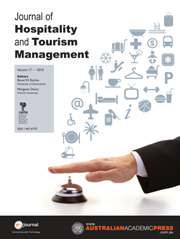Crossref Citations
This article has been cited by the following publications. This list is generated based on data provided by
Crossref.
Chambers, Donna
2014.
Encyclopedia of Tourism.
p.
1.
Lemelin, Raynald Harvey
and
Higgins-Desbiolles, Freya
2014.
Encyclopedia of Tourism.
p.
1.
Chambers, Donna
and
Buzinde, Christine
2015.
Tourism and decolonisation: Locating research and self.
Annals of Tourism Research,
Vol. 51,
Issue. ,
p.
1.
Walker, Kaye
and
Moscardo, Gianna
2016.
Moving beyond sense of place to care of place: the role of Indigenous values and interpretation in promoting transformative change in tourists' place images and personal values.
Journal of Sustainable Tourism,
Vol. 24,
Issue. 8-9,
p.
1243.
Lemelin, Raynald Harvey
and
Higgins-Desbiolles, Freya
2016.
Encyclopedia of Tourism.
p.
1.
Dann, Graham M. S.
2016.
Tourism Research Paradigms: Critical and Emergent Knowledges.
Vol. 22,
Issue. ,
p.
57.
Munar, Ana María
and
Jamal, Tazim
2016.
Tourism Research Paradigms: Critical and Emergent Knowledges.
Vol. 22,
Issue. ,
p.
1.
Caton, Kellee
2016.
Tourism Research Paradigms: Critical and Emergent Knowledges.
Vol. 22,
Issue. ,
p.
35.
Tribe, John
and
Liburd, Janne J.
2016.
The tourism knowledge system.
Annals of Tourism Research,
Vol. 57,
Issue. ,
p.
44.
Olsen, Lise Smed
2016.
Sami tourism in destination development: conflict and collaboration.
Polar Geography,
Vol. 39,
Issue. 3,
p.
179.
Holmes, Allison P.
Grimwood, Bryan S.R.
and
King, Lauren J.
2016.
Creating an Indigenized visitor code of conduct: the development of Denesoline self-determination for sustainable tourism.
Journal of Sustainable Tourism,
Vol. 24,
Issue. 8-9,
p.
1177.
Camargo, Blanca A.
Jamal, Tazim
and
Wilson, Erica
2016.
Tourism Research Paradigms: Critical and Emergent Knowledges.
Vol. 22,
Issue. ,
p.
73.
Pereiro, Xerardo
2016.
A review of Indigenous tourism in Latin America: reflections on an anthropological study of Guna tourism (Panama).
Journal of Sustainable Tourism,
Vol. 24,
Issue. 8-9,
p.
1121.
Seiver, Beverley
and
Matthews, Amie
2016.
Beyond whiteness: a comparative analysis of representations of Aboriginality in tourism destination images in New South Wales, Australia.
Journal of Sustainable Tourism,
Vol. 24,
Issue. 8-9,
p.
1298.
2016.
Tourism Research Paradigms: Critical and Emergent Knowledges.
Vol. 22,
Issue. ,
p.
203.
Corral-Marfil, José-Antonio
and
Cànoves-Valiente, Gemma
2016.
Tourism Research Paradigms: Critical and Emergent Knowledges.
Vol. 22,
Issue. ,
p.
167.
Chambers, Donna
2016.
Encyclopedia of Tourism.
p.
228.
Swain, Margaret Byrne
2016.
Tourism Research Paradigms: Critical and Emergent Knowledges.
Vol. 22,
Issue. ,
p.
87.
Ek, Richard
and
Tesfahuney, Mekonnen
2016.
Tourism Research Paradigms: Critical and Emergent Knowledges.
Vol. 22,
Issue. ,
p.
113.
Jamal, Tazim
and
Munar, Ana María
2016.
Tourism Research Paradigms: Critical and Emergent Knowledges.
Vol. 22,
Issue. ,
p.
191.




